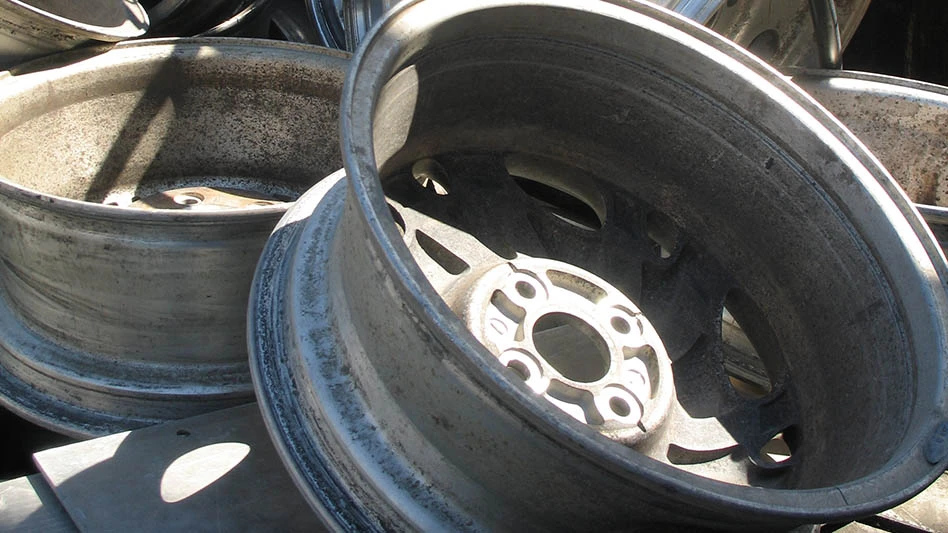 It's human nature to think in terms of pairs. Peas go with carrots, two heads are better than one, this company's working with that company to complete that project. This applies to automotive recyclers and scrap dealers as well. Doesn't it?
It's human nature to think in terms of pairs. Peas go with carrots, two heads are better than one, this company's working with that company to complete that project. This applies to automotive recyclers and scrap dealers as well. Doesn't it?
For Brookfield Resource Management, headquartered in Elmsford, N.Y., it does. Tom Malone, Brookfield Resource Management president, says, "The reality is, if you're in the used auto parts business, you are in the scrap business whether you know it or not. And if you're in the scrap business, it's to your advantage to be in the used parts business."
Brookfield employed vertical-integration-style expansion in July 2010 when it acquired a used auto parts company in Bronx, N.Y. The company also acquired a Montrose, N.Y., automotive parts operation in 2009.
Malone continues, "The biggest thing with vertical integration, for us, is trying to get a bit more margin out of what we are doing. I don't think it works all the time, and you have to try a couple different things. Ideally if you can find a few things that are not capital intensive to try, it helps." He concludes, "Bottom line improvement is what it boils down to."
JSL Management of Phoenix also has found success in vertical integration. The company is involved in the recycled auto parts, scrap metal and towing industries through its businesses Pick A Part, Just Truck and Van, We Buy Scrap/Liberty Southwest Metal and All City Towing.
Dan Rush, CEO of JSL Management, says, "As the auto recycling divisions were growing, we needed more salvage. We were looking for ways that would bring us more vehicles for the auto parts but, all the while, maintaining a low cost of goods. After reviewing the cost of transportation against the costs of purchasing a tow truck, it was clear that the ROI (return on investment) with the tow truck would outweigh the cost of transportation for towing these vehicles.
"Once our staff became familiar with transporting vehicles," he continues, "it was a natural growth to offer our truck for outside towing opportunities. However, the decision was based on obtaining the salvage."
This approach can be appealing to companies in the scrap industry because automobiles provide a rich source of scrap metals.
Malone says, "By sheer volume, automobiles are some of the largest sources of scrap metal." He adds that harvesting re-usable materials to maximize their value combined with the scrap metal generated from end-of-life automobiles gives his operation "more buying power and more selling opportunity."
In addition to location and market conditions, Malone says he keeps in mind the differences he has seen between auto parts and scrap metal prices when it comes to harvesting parts.
"If you are a used auto parts operation and you are going to inventory parts, think of all the different types of parts," he says. "You have all the different parts of a car and then you have all the different makes and models."
Auto parts recyclers are faced with maintaining large inventories covering a variety of parts and models, "whereas, with scrap metal you have a very manageable selection of individual products," Malone says. "There are only so many ferrous products. Granted there is a fair amount of nonferrous scrap products, but it is nowhere near the number of products a used auto parts operation is going to handle."
Growth potential is among the deciding factors for Rush. He cites JSL's towing operation as an example of an acquisition that was made in part based on the ability to grow that segment of the business. Vertical integration has allowed JSL to see how the cycle is evolving. Increased industry knowledge proved useful in managing the core of JSL's business, according to Rush.
"For our company model, auto recycling is the core to all three of the businesses we are in. Towing is an expense, and scrap metal is revenue. By having the industry knowledge and awareness of market trends, it has proven helpful in managing the auto recycling side of the business," he says.
Malone and Rush say their approach to vertical integration has been a natural fit for their businesses and initially things just fell into place.
Rush explains, "This vertical integration happened naturally as the business grew. Expenses were analyzed, and opportunities in the marketplace presented themselves. But, most importantly, all integration occurred because it is about obtaining the car and securing the salvage."
He continues, "As the business grew and internal and external towing needs grew, we made the decision to purchase more tow trucks. Eventually, our towing operation was born, and that has led to an independently successful operation.
"In the same manner, as our auto recycling facilities grew, we realized the market opportunities in scrap metal recycling," Rush says. "Although different industries, the commodity is similar. As with all auto recyclers, our products are eventually sold for scrap metal. Once we realized the potential and could obtain the capital needed, it was a natural migration into this industry and allowed us to maximize our scrap metal purchasing power." He concludes, "Again, we were obtaining salvage."
 Ross Kogon and Steven Levetan of the Atlanta-based do-it-yourself used auto parts chain Pull-A-Part also found themselves expanding into the scrap business. (The September 2007 profile of Pull-A-Part in Recycling Today can be accessed at www.RecyclingToday.com/Article.aspx?article_id=20763.) Eventually, however, the company left the scrap business behind, and Kogon and Levetan turned their focus back to the auto supply business full force.
Ross Kogon and Steven Levetan of the Atlanta-based do-it-yourself used auto parts chain Pull-A-Part also found themselves expanding into the scrap business. (The September 2007 profile of Pull-A-Part in Recycling Today can be accessed at www.RecyclingToday.com/Article.aspx?article_id=20763.) Eventually, however, the company left the scrap business behind, and Kogon and Levetan turned their focus back to the auto supply business full force.
Kogon, CEO of Pull-A-Part, says an auto parts yard cannot supply enough material to keep an associated scrap yard busy. "You're going to have to buy a lot of material from outside customers, no matter what," he says.
"There's just not a parts yard big enough that you could run that you would not have to worry about buying from outside customers," Kogon adds.
Levetan, senior vice president for Pull-A-Part, adds, "It comes down to definitions, and our definition of vertically integrating means you control that supply chain, so you're protected and don't have to go outside the supply chain. There is relation to the businesses—they have some similarities but they aren't vertically integrated. You're still subject to outside market forces for a significant portion of your supply chain. I can't insulate myself from risk by being further up the chain or longer up the chain, which is the idea of vertical integration," Levetan adds.
Kogon and Levetan say that they understand the appeal of wanting to work within an integrated scrap business and auto supply business, but add that their experience left them with a new understanding of these two industries. They also came to the conclusion that just because they had purchased a scrap yard did not mean they were truly in the scrap industry.
Kogon says he has a lot of respect for both industries, adding that he feels they are too different to believe that someone can successfully be involved in both.
JSL arguably may have found a solution to the issue Kogon poses. Rush says the company has tried to avoid putting blinders on and thinking its vertical approach to business makes it untouchable. Rather, he says, the understanding of the markets that JSL's position affords is a tool, part of the larger picture.
"Our companies are managed separately from one another, and we feel that it is important to keep each one separate, so that we do not become dependent on one and/or ignore another," Rush says. "However, by being active in vertically aligned industries, we can better predict market trends, customer needs and future opportunities."
Looking toward the future, Malone says vertical integration is still integral to Brookfield Resource Management's growth plan. In addition to its Bronx location, Brookfield also has expanded into other parts of New York, as well as into Chicago and overseas to India.
Rush also says he believes there are opportunities out there worth pursuing. Regarding how he plans to approach these opportunities, Rush says, "If a company has the appropriate funding and risk tolerance, the current economic climate is great for acquisitions. However, it is also a very risky time, as the auto recycling industries are showing signs of huge fluctuations. Full-service is becoming more specialized, and self-service yards more plentiful. Market conditions in the area of interest need to be evaluated before any acquisitions are considered."
He adds, "It may be better to invest in your own company in other ways versus purchasing another location."
Rush advises against viewing vertical integration as a means for rapid expansion. He instead suggests considering how it can contribute to the overall outlook of the existing business.
The author is assistant editor for Recycling Today and can be reached at kstoklosa@gie.net.
Get curated news on YOUR industry.
Enter your email to receive our newsletters.

Explore the October 2011 Issue
Check out more from this issue and find your next story to read.
Latest from Recycling Today
- Steer World offers PEX plastic recycling machine
- New recycling grant program launches in Massachusetts
- Tire Recycling Foundation names executive director
- Dock 7 named 2025 Exporter of the Year at New Jersey International Trade Awards
- Waste Connections reports ‘better than expected’ Q1 results
- Commentary: How EPR is transforming the packaging industry
- Acerinox names new North American Stainless CEO
- Greenwave closes 2024 books with red ink






